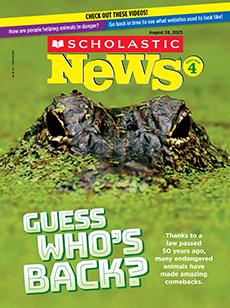1. Why might a fuzzy or faraway photograph make it easier to speculate about Nessie’s existence?
Sample response: A fuzzy or faraway photo might make it easier to speculate about Nessie’s existence because in those circumstances, everyday items like boats or lake animals cannot be seen clearly. People can point to one of those shapes and wonder if it is a monster.
(RI.4.3 Explaining Ideas)
2. What were the results of this summer’s search for Nessie?
This summer’s search for Nessie failed to turn up any proof that the monster exists.
(RI.4.5 Chronology)
3. What does Loch Ness monster expert Adrian Shine mean when he says that “people want to believe”?
Adrian Shine probably means that it is fun or exciting for people to keep the legend alive and think that a monster lives in Loch Ness. That’s why they keep looking for Nessie even though there has been no evidence of the creature’s existence.
(RI.4.1 Inference)
